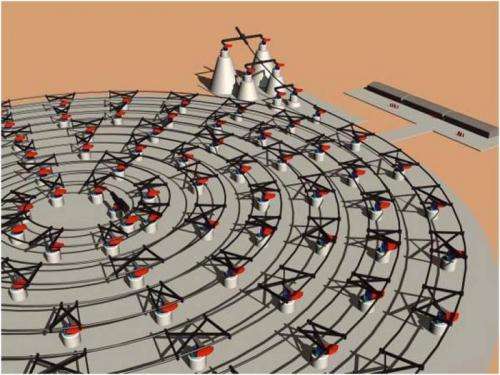July 25, 2013 report
Slingatron vision is to launch payloads into orbit

A Kickstarter project features Slingatron, the work of a seasoned team of scientists as a way to put cargo into orbit. The Slingatron is a mechanical, hypervelocity mass accelerator. The inventor of the Slingatron is Dr. Derek A. Tidman, author of the book, "SLINGATRON - A Mechanical Hypervelocity Mass Accelerator." The book sets forth the concept and now Hyper V Technologies of Chantilly, Virginia, the project leaders, are to put the Tidman concept into action.
Tidman is part of the Hyper V Technologies team presenting the Kickstarter project. According to his biographical notes, he first came to the U.S. as an assistant professor at the Fermi Institute for Nuclear Studies, University of Chicago. In reviewing the book, Daniel Spicer, senior scientist, Emeritus, NASA Goddard Space Flight Center, commented that "the Slingatron is a highly imaginative and surprisingly simple approach to accelerate large masses to hypervelocity using just off-the-shelf technology and good old-fashioned classical Newtonian mechanics."
A generous display of descriptions on how it works is on the Kickstarter page. The Slingatron technology can be incrementally grown in performance and size to launch payloads into orbit. The Kickstarter project goal is to build and demonstrate a modular Slingatron to launch, in the team's laboratory, a 1/4 pound payload to 1 kilometer/sec. That is about 2,237 mph. If launched straight up at that speed, a payload would reach an altitude of about 51 km, neglecting air resistance, they said.
They have turned to Kickstarter for the next step in making Slingatron a reality and that next stage will give them technical information, practical experience, and cost data on what will be required to build a full-scale Slingatron orbital launch system in the future. They said they plan to use Kickstarter funds to build a modular, horizontal Slingatron device that is five meters (16.4 feet) in diameter and capable of gyrating at 40 to 60 cycles per second (cps).
"This Slingatron will be designed to be able to launch a 0.454 kg (1 lb) payload at a velocity of one kilometer per second, but will only be operated with 1/4 lb payloads for the demo. It will take us approximately six months to build and test the demo device."
The project will only be funded if at least $250,000 is pledged by Aug 22. They are inviting pledges from one dollar to $10,000 and above. At the time of this writing they raised $4,842 with 28 days to go.
HyperV Technologies is focused on producing "the world's first commercially viable fusion reactor technology." Their research efforts are on the development of a "controlled hot fusion reactor that is scalable to provide from 100 MW to 2,000 MW of clean baseload electric power."
More information: www.kickstarter.com/projects/3 … -a-railroad-to-space
© 2013 Phys.org





















